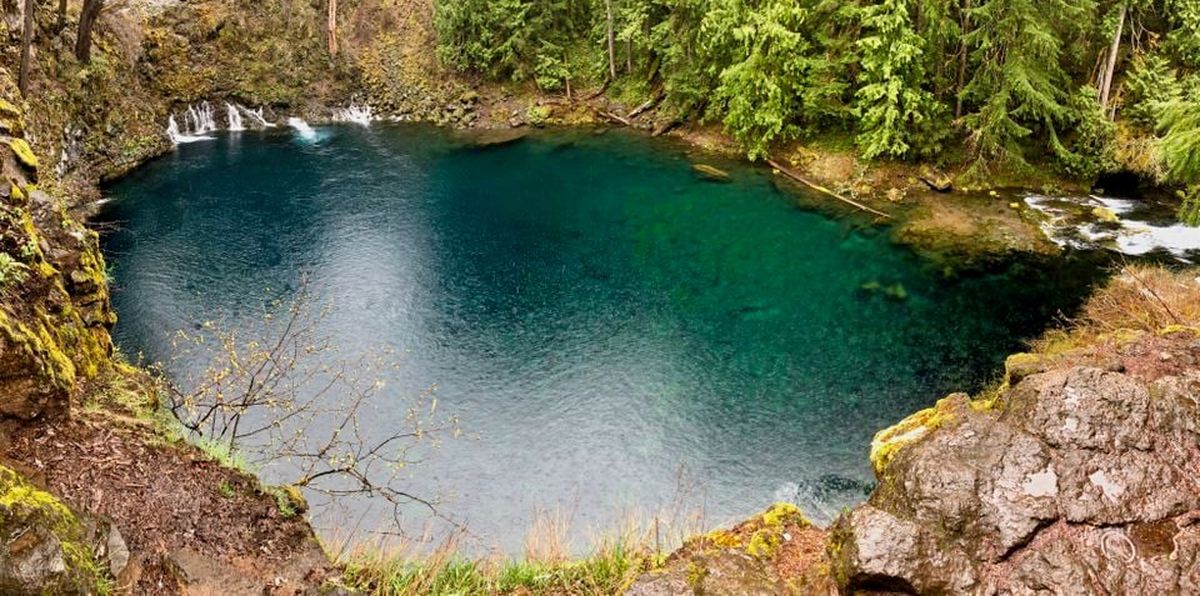Blue Pool swimming ban is in the works as 5 people are rescued in 3 days

Blue Pool has a problem.
Rescue crews and forest officials sounded alarm bells this week after five people in three days required rescues at the popular summer destination, found along the McKenzie River in Oregon’s central Cascade Mountains.
The Sweet Home Fire District, one of several agencies that does rescues at Blue Pool, said rescue crews carried two people off the trail on July 15. Two days later, crews rescued three people at the site. On July 2, another injured person had to be airlifted out by the U.S. Coast Guard.
Officially known as Tamolitch Falls, the pool is known for its clear waters, lush forest and the numerous ways people find to injure themselves there.
There are those who jump into the pool and immediately go into shock in the icy cold water (which averages about 37 degrees) and there are those jump into the pool and miss. There are the people who fall by accident, and the people who struggle on the rugged trail, completely unprepared for the experience.
Darren Cross, McKenzie River district manager for the Willamette National Forest, said it can take up to seven hours for a person to be rescued: an hour to hike to cell service, two or three hours for rescue crews to arrive, another two hours to hike out, and a little over an hour to get to a hospital.
“People go out there and they do these dumb things, and they get hurt and it’s a huge burden,” Cross said. “This has been a problem for us for a long time.”
For Linn County Search and Rescue, the hours can be even longer since they respond from Albany, the agency told KCBY. Most calls bring about 20 responders from multiple agencies.
The recent issues at Tamolitch Falls can be traced back to around 2013, Cross said. Following the launch of Instagram a few years earlier, Blue Pool had been exploding in popularity. That spring, a University of Oregon tennis star died after diving into the water. In 2015, a Bend photographer died after falling from the cliffs. Those incidents have not seemed to deter the risk-takers who continue to share cliff diving videos on social media, which are now found next to videos like the helpfully titled “How Not to Die at Blue Pool.”
Changes are coming. In 2022, responding to the rash of incidents, the Willamette National Forest approved a rule that would add several safety measures to the pool and ban swimming altogether – though it could be several years before those measures get underway.
The rule change was part of a broader environmental assessment and will also result in construction of a larger trailhead parking lot, a toilet at Blue Pool and a two-mile re-route of the McKenzie River Trail – all part of an effort to keep visitors safe, protect the natural environment and reduce congestion, officials said.
Cross said it will likely be three to five years before any construction is done, though the swimming ban could come sooner.
The only holdup of the ban is enforcement, a task that seems practically impossible. Jumping into Blue Pool – a frigid pool of water surrounded by jagged rocks – is extremely dangerous but not necessarily illegal. The U.S. Forest Service could hand out fines, but some people may decide a $50 ticket, for example, is worth the risk.
“Once people go there, there’s no way to control what they do,” Cross said. “I don’t know that people understand how serious the dangers are.”
Like many other agencies, the U.S. Forest Service has linked the incidents to the boom in outdoor recreation over the past decade. Annual data isn’t kept for Tamolitch Falls, but Oregon’s state and national parks have reported record crowds in recent years.
Rescue missions have not seen the same trends.
Statewide, the number of rescues have stayed somewhat consistent. In 2021, Oregon recorded 1,078 search and rescue missions compared to 1,049 missions in 2011. In that time, annual numbers spanned between a low of 924 missions in 2015 and a high of 1,305 in 2019.
Still, any increase in rescues, like the rash of six in July, could spell trouble for local emergency officials who are already spread thin.
Shannon Pettner, battalion chief for the Sweet Home Fire District, told the Register-Guard that poor radio communications, rough conditions and long travel times put a lot of strain on emergency services in the remote area around Tamolitch Falls. The fire district responds to calls along with Linn County Search and Rescue, Eugene Mountain Rescue and other organizations, and often sends multiple people to the trail.
“We just can’t really afford to be without those resources for other calls in our area,” Pettner told the newspaper. “The increase in call volume up there is really straining our system.”
The Willamette National Forest is tasked with managing recreation at the site, but Cross said the agency can only do so much to keep people safe. There was talk of requiring permits to hike the trail, he said, but the idea was shot down. Shutting down the site completely is off the table. New barriers and signs will go up eventually, but until then education is the best tool available.
Responsibility ultimately rests in the hands of the visitors themselves, Cross said. People will simply need to decide for themselves to not make risky decisions at what has become one of Oregon’s most notorious natural attractions, though he’s not so confident people will make the right choices.
“I’m exasperated by it,” Cross said. “I just don’t know what to do.”